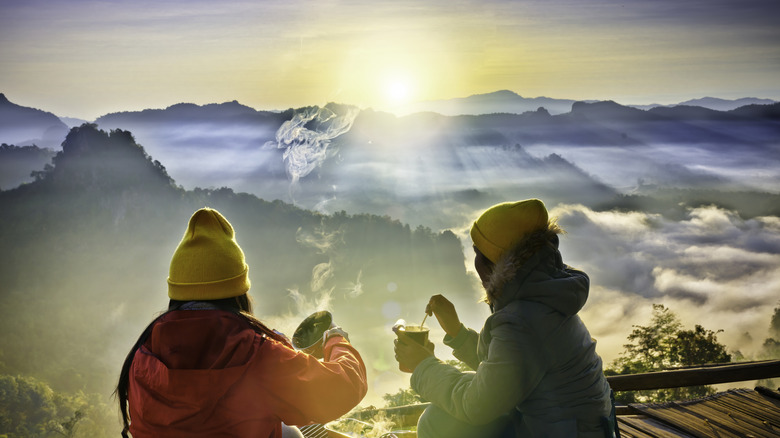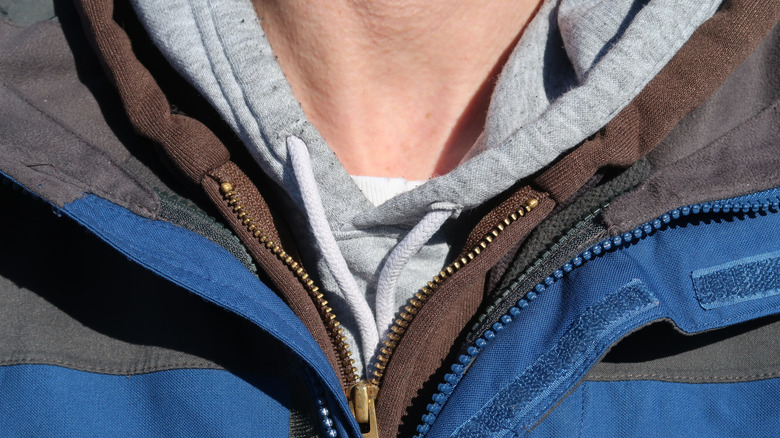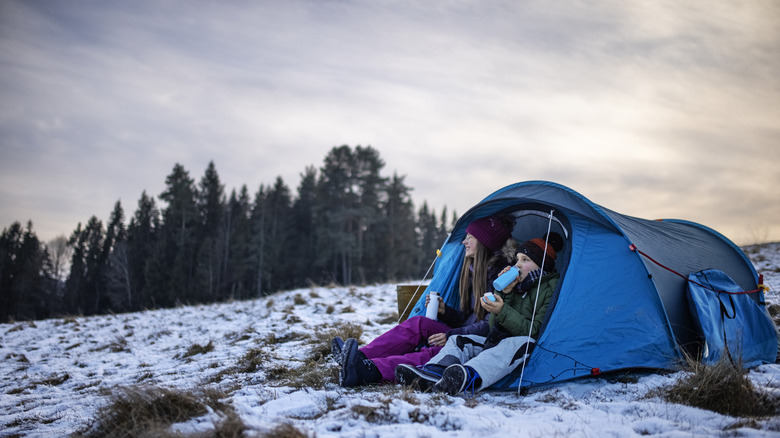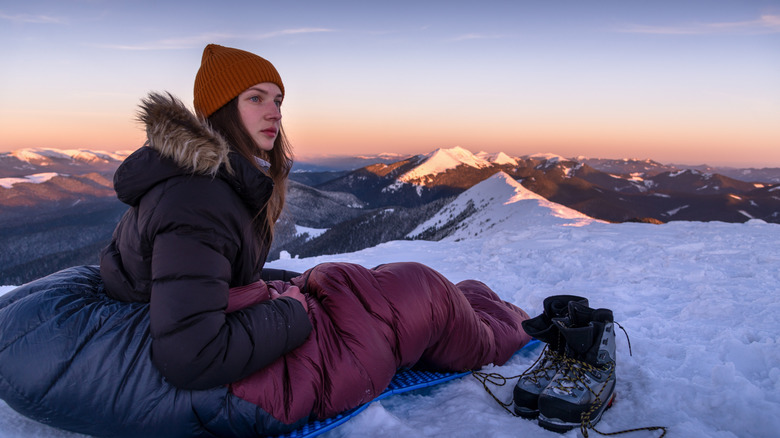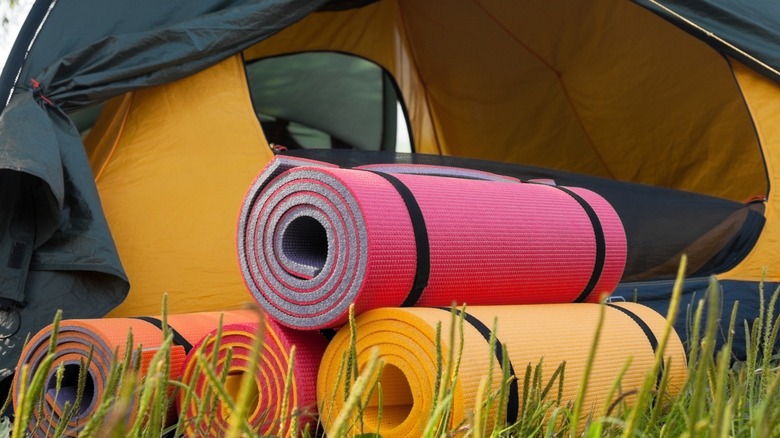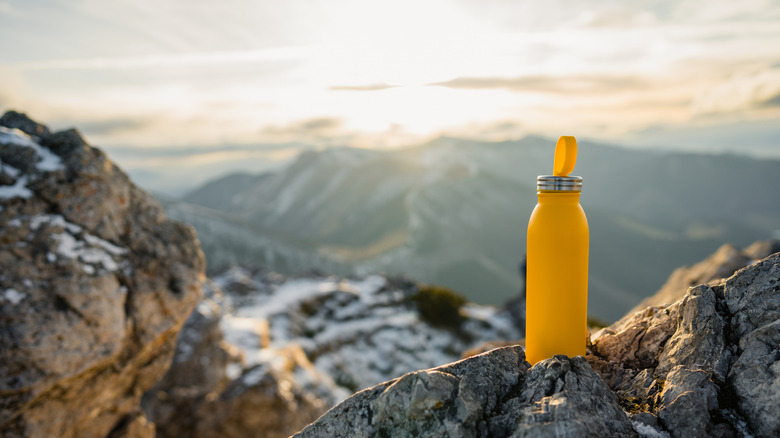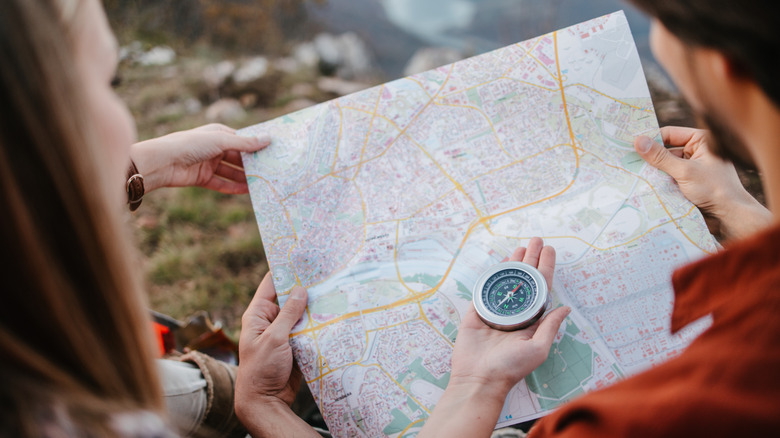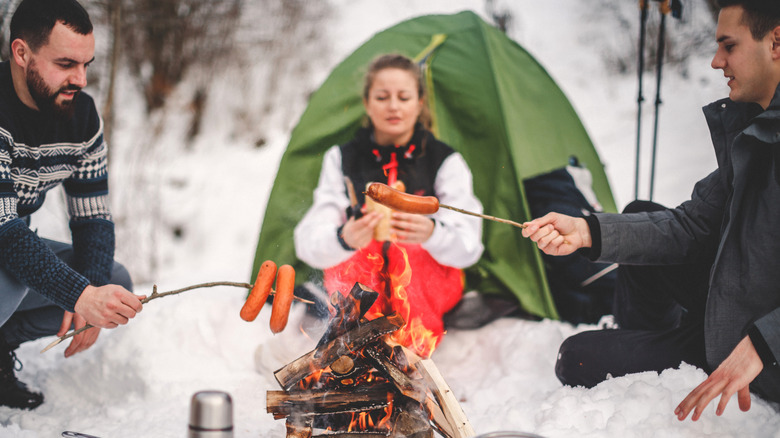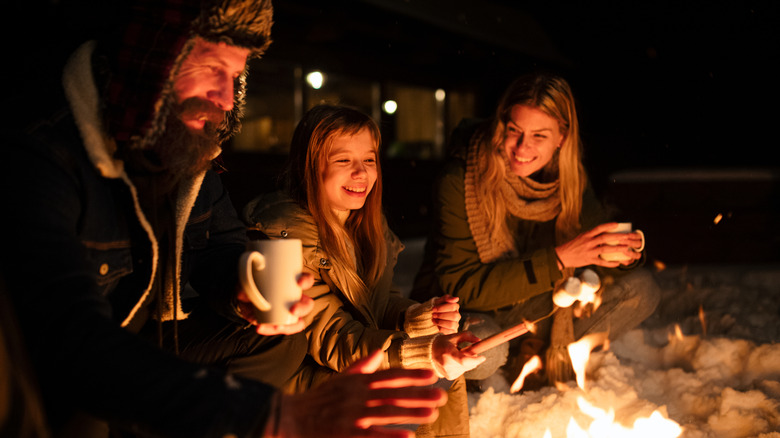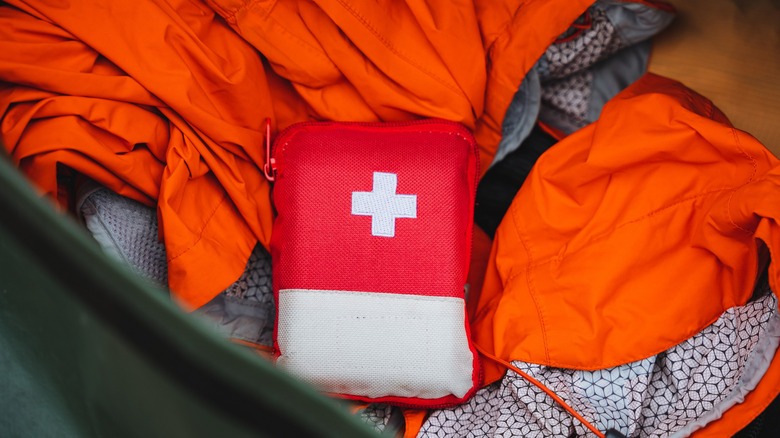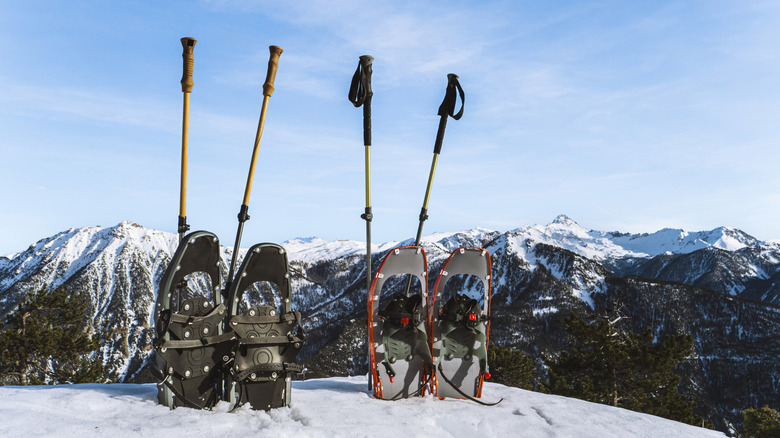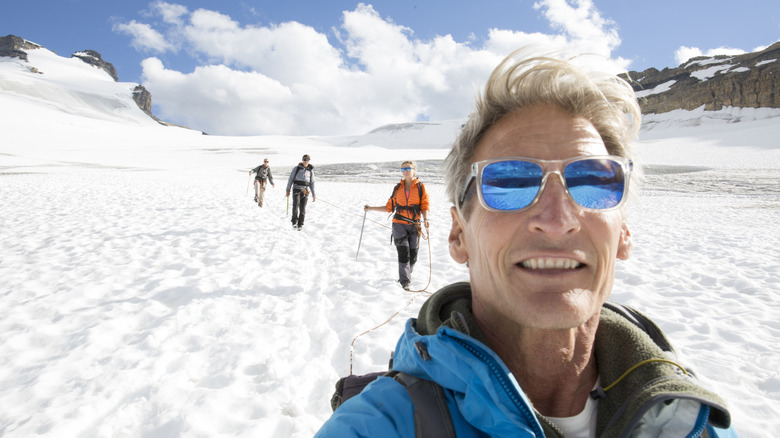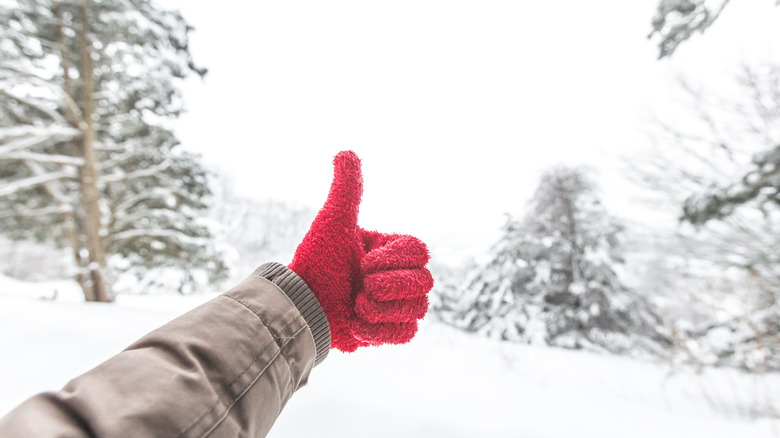Essential Gear You Should Pack For Your Winter Camping Trip
We may receive a commission on purchases made from links.
Landscapes change with the passing of the seasons, but none are more transformative than winter. Having access to an area that can be completely changed by a small snowfall is part of what makes winter camping so appealing to so many people. While the season certainly doesn't draw the masses of summer, there are still plenty of reasons why it's worthwhile.
If you've never gone camping in the winter, maybe it's time you tried. However, there is something you should know. You are going to need a lot more gear than you would for a night's camping in the summertime. Due to colder temperatures and the ever-present potential for snow, the essential gear list for a winter camping trip is one that needs to be strictly adhered to.
But what exactly are the essential gear items you should pack for winter camping? They are a combination of things that are all designed to, primarily, keep you safe and warm. None of these following items should be left off of your packing list for a winter camping trip.
Stay warm by layering
Cold temperatures are the reality of winter camping. Whether temperatures will drop well below freezing depends entirely on where in the country you've decided to camp. In any case, the key to enjoying your trip is to stay warm. There is no better way to achieve this than by layering your clothing when camping in the winter.
Layering can be divided into three levels: base, mid, and shell/outer. Base layers sit tightly against the body, providing the primary insulating layer that keeps your body heat trapped. The best material for this by far is merino wool. It is a sustainable material that easily wicks cooling moisture away and keeps you warm even in the most frigid conditions.
Mid layers are everyday wear like socks, pants, sweatshirts, and mid-weight jackets like an Eddie Bauer down jacket. The shell layer is the outermost layer that is going to do the most work to keep the elements out, like waterproof Maoyssen Ski Jackets and insulated boots. When it comes to winter camping, enjoying the elements, but keeping them away from your body, are important to enjoying your trip.
Shelter safe with the right tent
Shelter is the most important thing when camping. It is what protects you most from the elements, including extreme heat and rain. In the winter, however, shelter becomes especially important. While you can feasibly get away with camping under the stars well into autumn, in winter, having a shelter can mean the difference between staying warm and freezing.
The most common shelter for campers is a tent. There are several different types of tents that range in size and shape, but the ones to take into consideration for winter camping are the three season and the four season tent. A three season tent is the most common type. Capable of withstanding light to moderate snow loads and providing decent insulation, they should be more than sufficient for a cold night or two, especially if you have other means of keeping warm.
If you are going to be camping in an area known for extreme winter temperatures combined with a heavy snowfall, nothing less than a heavy-duty, four season tent will do. These are built with extra strong poles and fabrics to withstand heavy snow loads, high winds, and even thunderstorms, and are well insulated to keep out the cold. Some even come with an exhaust port for a camp-sized wood stove.
Keep out the cold with the right sleeping bag
While a tent will do the job of keeping wind, rain, and snow at bay, it is certainly not the same as spending a winter's night in the comfort of your own warm, insulated home. This is why the layering we talked about earlier is so important. However, on equal footing as layering is the sleeping bag you choose to spend the night in.
Not all sleeping bags are up to the task of keeping you warm on a frigid night. The one you choose needs to be properly rated for winter temperatures. Again, much of your choice is going to be influenced by the area you are camping. In general, though, aim for sleeping bags that are rated to keep you warm at temperatures at, or below, 20 degrees Fahrenheit. That way you are guaranteed warmth if the temperature dips further than expected. As for materials, down has long been considered the best if you have the budget for it.
Certain brands, such as Marmot's Never Summer sleeping bag, are well reviewed and are certain to keep you warm on some pretty cold nights. If you don't have the funds for a new sleeping bag, consider purchasing a thermal liner to increase the cold hardiness of your current bag. A Sea to Summit Thermolite Reactor Extreme Sleeping Bag Liner is a budget-friendly way to keep you enjoying your outdoor winter slumber. Using heated rocks is another great, no-electricity-needed method of keeping your sleeping bag warm.
Sleeping pads will keep the cold ground at bay
You lay a tarp down on the ground before pitching your tent to add an additional insulating layer between you and the earth, preventing moisture from getting inside and extra protection from rocks or roots. In the winter, the cold of the frozen ground will eventually creep past this layer. As such, sleeping directly on the floor of your tent, even in a sleeping bag, will suck heat away from your body.
This is why you need to pack a sleeping pad. It acts as a quasi mattress, creating a barrier between you and the ground. It will better insulate against the cold thanks to its thermal properties, while also keeping you more comfortable than you would be sleeping on hard earth.
Therm-a-Rest makes an excellent inflatable sleeping pad that can be easily stowed in a backpack. Another option would be a closed-cell foam pad, which Therm-a-Rest also makes. These store slightly bulkier, but are easier to set up because you can simply unfold or unroll them as opposed to time spent inflating one. Whichever you choose, that barrier between you and the ground will go the extra mile in keeping you warm while you're sleeping.
Water bottles are for more than just hydration
Hydration is vitally important when you are camping, so having several water bottles on hand is a must. It would also behoove you to bring along electrolytes for additional energy boosts for slow mornings, and an insulated thermos for warm beverages like tea, coffee, hot cocoa, even soup broth. But drinking is not the only thing your water bottles can be used for. We're gonna get a little personal here, but bear with us.
Naturally, when you've had a lot to drink, you are going to need to urinate. You might not want to, considering how cold it is outside of your sleeping bag, but you need to for your own comfort. As such, you can reserve one of your water bottles as a pee bottle to keep in your sleeping bag.
Not only will this prevent you from needing to exit your sleeping bag to go pee, but the urine itself can act like a hot water bottle of sorts. As it's coming out of your body at a warm internal temperature, the urine will remain warm if properly insulated. Keeping it in your sleeping bag, as gross as it may seem, will actually help you stay warmer. Trust us, if ever you get trapped in a snowstorm, sleeping with a pee bottle becomes far less of a problem.
Navigation tools will keep you on track
Having a compass, map, and GPS devices are essential camping tools regardless of season. It doesn't matter whether you're heading to your favorite spot, or backpacking through the woods, having working navigation is, in some cases, the difference between life and death. And there is a very specific reason why you want to have navigation when you are camping in the winter.
As beautiful as a nightly snow might be, it can completely transform even the most familiar environment. Snow can cover up trail markers, signs, footprints, and even complete trails, creating a unique landscape that can leave you absolutely directionless.
As such, being equipped with the right navigation equipment in order to find your way back, or even just to orient yourself, is a safety priority. GPS, like a Garmin Etrex22X, is a fantastic modern tool, but it has its limits. Loss of signal and battery life, especially in the cold, could leave you without a paddle if you don't have backup. Therefore, knowing how to read a map and a compass are going to be crucial after a snowstorm. In short: never be without navigation.
Nutrient-dense, energy-filled foods
Like hydration, keeping your body fueled is incredibly important when camping in the winter. This is no time to count calories. A fresh garden salad, while lovely and flavorful, is not going to do the job of keeping you full. You need nutrient-dense foods packed with fat to keep your energy levels up. As your body processes it, the fat will help keep your temperature regulated, as well as keep you focused during those colder moments.
There are plenty of wonderful camping recipes you could cook for a winter adventure. Things that are hearty and easy to reheat over a fire, like chili, stew, hot dogs/sausages, or even mac and cheese are going to be ideal.
You'll also want to have plenty of smaller snacks to pick at between meals. The same rules apply here as before: nutrient dense and fatty. Think cheese, assorted nuts, trail mix, nut butters, chocolate, granola, or jerky. Eating snacks consistently throughout your winter camping trip will continue to keep you full and energized. And having a full stomach is going to help keep you happy, even on the coldest night.
Cooking fuel and firemaking tools
We've lumped cooking fuel and fire-making together because, in many cases, a fire is the only means by which food is going to be cooked at camp. Therefore, you need to have the right tools that are going to be able to help you get a fire started, even in the wet, cold snow. Dry tinder, matches, a fire striker, and a hatchet for cutting wood are all necessary. Even a bag of chips can come in handy for a successful winter fire.
It is also always a good idea to bring additional fuel. The types of fuel and cooking tools you bring depend entirely on the type of camping you are doing. Small cook stoves and propane burners are great for tent camping on a site where you can use your car or boxes for additional storage. If you're backpacking, you'll need something more portable.
The Jetboil Flash Camping and Backpacking Stove System or smaller, single burner cook stoves are easily transportable and will cook small portions of food, or drinks like coffee, in a very short period of time. These come in handy earlier in the day, when you want to warm up fast without having to wait for a fire to burn down to coals.
Always bring emergency supplies
This may not be winter camping specific, but we cannot emphasize enough the importance of being prepared with emergency supplies while you are camping. A backpack well stocked with these essentials could very well save your life in some instances. While first aid is the most important, there are winter specific items worth having on hand.
First is the means to make a shelter. If you get caught out hiking in a storm before you have the chance to get back to camp, having a tarp and some rope on hand will allow you to make a small shelter in which you can wait out the storm. Likewise, having a small shovel to dig yourself a little windbreak or shelter out of snow is also essential.
We also recommend having an emergency thermal blanket. These are made with reflective metal designed to trap your body heat and keep you from freezing. They fold small and can easily be packed into a backpack. Flares are also a great thing to have in case you get stranded, as well as a two-way radio for communication.
Snowshoes, skis, and trekking poles
While it is not always a guarantee that you will see snow on your winter camping trip, why take the chance and be unprepared? If you choose to camp in an area known for snowfall, like most of the northern and midwestern United States, then you need to be prepared with tools that are going to allow you to transport yourself through said snow with ease. This is why it is a good idea to bring along a pair of snowshoes or cross country skis, and their respective trekking poles.
Snowshoes are the more accessible of the two. Besides getting your sizing right, there is really no trick to working with them. Snowshoes displace your weight across the snow, creating a wider footprint that prevents you from sinking too far down into the powder. They also provide additional traction and stability, making them great options for maneuvering around your campsite.
Cross-country skis require a little more time to get the hang of, but they are also pretty straightforward. These are great for longer distance travel across sloping terrain. The skis give you the momentum and stability, while the poles provide that extra bit of stabilization, as well as aid in climbing up hills. While you may not always need them, you'll be glad to have them.
Beat the glare with sunglasses and sunscreen
Snow glare is a common occurrence in the wintertime. It happens when the sun is out in full force, and reflects off of the brilliant white show. If there is an ice layer over the snow, the sheen can become almost blinding. This is why you should be prepared with sunglasses when you are out camping for the winter.
You'll often see mountaineers and other winter sports players wearing sunglasses. The tinted lenses help reduce the glare, allowing you to see better and keep your eyes protected. Snow glare can be incredibly damaging to your eyesight. Snow blindness is a common side effect of not protecting your eyes from the glare, and permanent damage can be done to your eyes if you are exposed to snow glare for too long. So, make sure you're packing sunglasses. Even if the glare is minimal, you'll find that sunglasses greatly benefit your impaired vision.
Sunscreen is another important thing to carry and use in the winter. That same glare coming off of the snow is reflecting the sunlight right onto your skin. Winter sunburns are highly common with skiers, snowboarders, and mountaineers, and can often be much worse than one you'd get in the summertime. Prevent this by taking the extra time to make sure you are applying it properly.
Gloves keep your hands from freezing
These last two things to remember are gear items that too many campers tend to forget. We did not list gloves in the layering section because we believe they are worthy of their own mention. Your hands are your most important tool when you are camping. They cook the food, chop the firewood, and do a whole manner of different chores that need to be done while you are out camping. So, keeping them from freezing is a top priority.
Gloves provide additional thermal protection and allow you to maintain your dexterity. Make sure you have a few pairs that you can layer like your clothes. Liner gloves are the first layer. Their thinness allows freer movement of your hands and are great when cooking or cutting wood. Thermal or mid-weight gloves are great for hiking and more demanding outdoor tasks. Heavyweight gloves or mittens are reserved for the coldest of conditions. All layers should be able to withstand severe cold, and the outer shells should be waterproof to keep your hands from getting too cold.
There is always more you could take, but these 12 items are the absolute essentials for a chilly camping experience. Make sure you have what you need and enjoy the winter weather!
